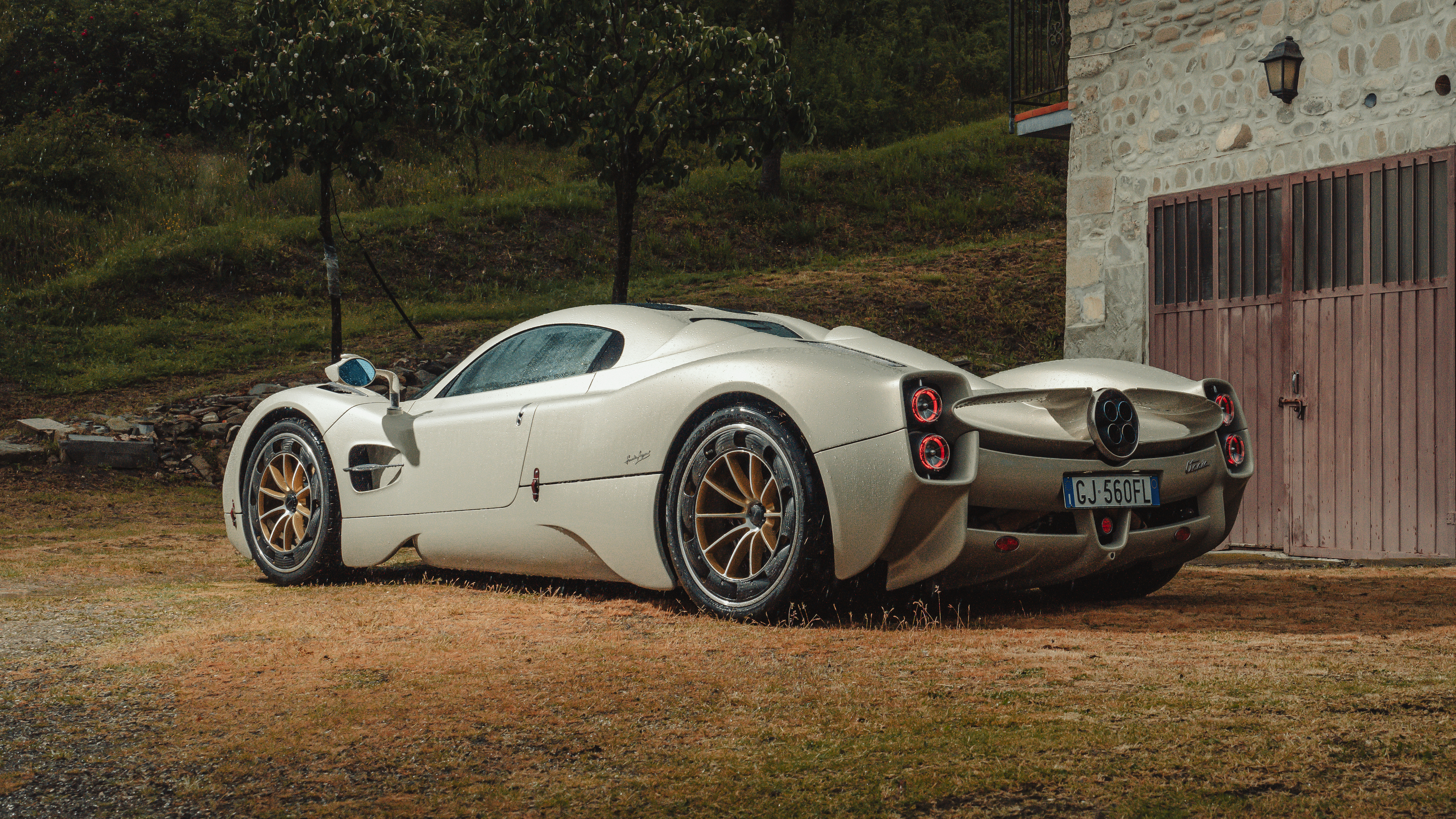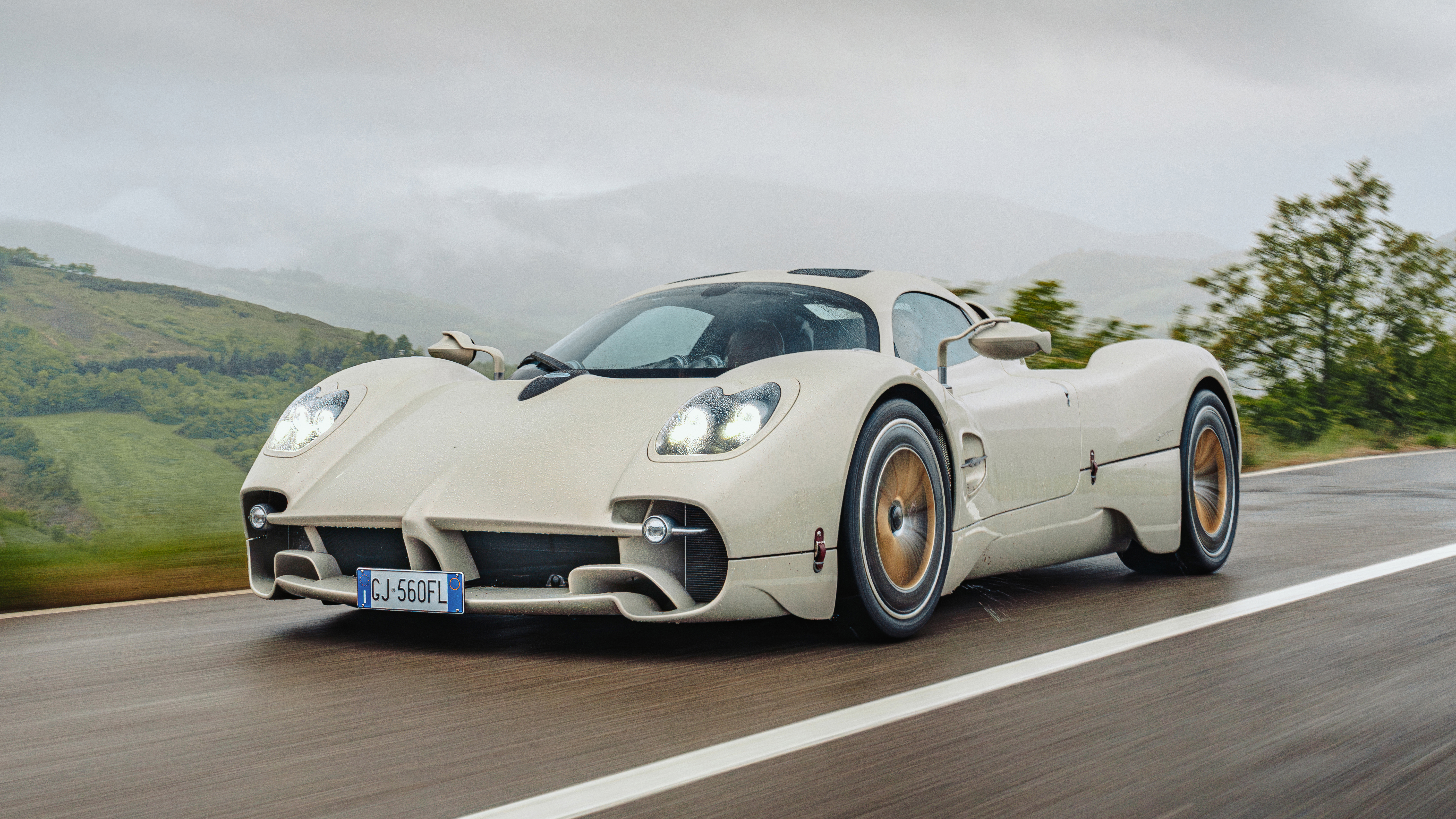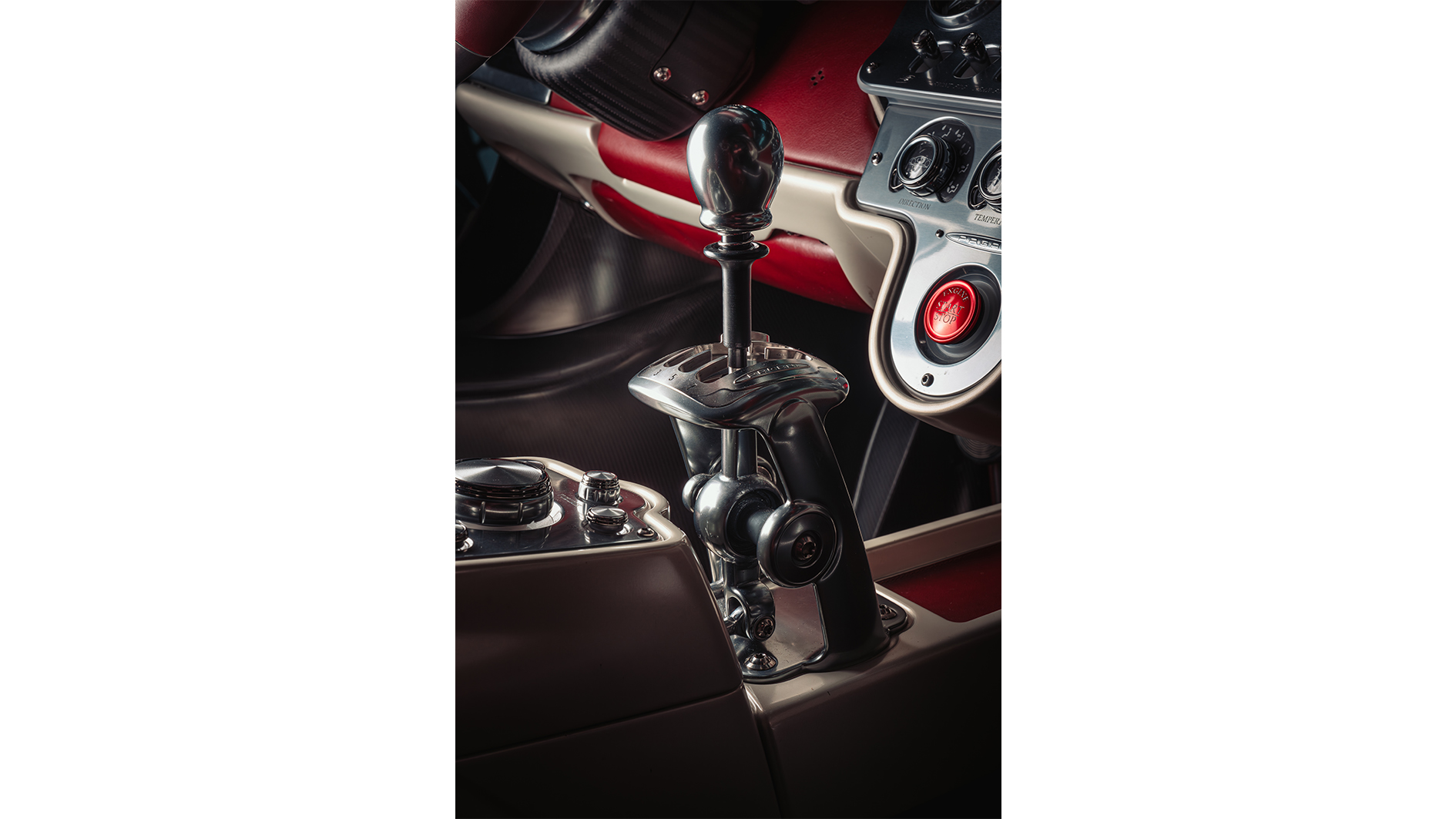
"Like driving a baroque theatre": testing the V12, manual Pagani Utopia
No car seeks to blend performance and art quite like a Pagani. The Utopia pushes both to the absolute limit
Where to start? It’s a toss up between wing mirror and gearbox. And the weather come to think of it. But let’s go with the initial plan and tell you about the side mirror. Because look at it. It’s more steampunk street lamp than functional item. Wonderful, but needlessly elaborate.
Welcome to the world of the Pagani Utopia – a Jules Verne fever dream for the 23rd century. Done with the mirror? Then have a look at those bonkers carbon wheel spats, the brake calipers like bronze knuckle dusters, the elegant slivers of aluminium, the leather buckles, the roof portholes. It’s a 1930s vision of the far future, Flash Gordon’s motor conveyance. Pagani likes to claim its cars perfectly balance art and science, but I walk around it convinced it’s all about the art, the sculpture, the effortless luxury, certain that functionality has been willingly overlooked, that Pagani has let the weight swell.
And then I drove it.
Photography: Mark Riccioni
The ride is supple and composed, the Utopia calm in my hands, the clutch easy, the motor tractable, the manners polished. Later in the day I’ll discover how sharp and fizzy the twin turbo V12 is, that there’s an animal contained within. Later still, the roads will finally dry out giving the Utopia a chance to demonstrate its eager, tenacious front end, suspension finesse and rampant, explosive, exponential acceleration.
Those mirrors. There’s no wind noise. No flex at speed. They’re well positioned for visibility, the reflective area is big and, when you park, they pivot on gorgeous aluminium base plates, twisting in to make themselves slightly less vulnerable. They work flawlessly. They’re still perfectly useful in the thumping rain and thick spray I’m currently enduring.
But we’ve got it easy. Cars coming the other way are shedding snow from their roofs. I call a halt to my plan to head further and higher – £2.2 million cars whose only contact patches with the already treacherous surface are track focused, ready chilled Pirelli Corsa tyres needed to be afforded plenty of respect. Already there have been spits of wheelspin as 811lb ft of torque bombardment is hurled at the traction control’s defences.
They’re robust I’m pleased to report and like I said, I’m not phased because the Utopia is fluent. I’m goading the accelerator because I’m comfortable with it already. And this despite having to wrestle with a manual gearbox. That’s right. No tricks or special technology here, this is a three-pedal Pagani. With a seven-speed gearbox that starts with a dogleg and is four planes wide. I’ve driven Astons with this gear layout and wished for an auto (you can have this as an auto if you want, but only 25 per cent of owners are).
I’m not going to say this has been developed by choirs of angels and divine intervention, but the shift is far sweeter and lighter than it has any right to be. And I swear Horacio and his merry band of artisans have done something very clever with the self-centring – it seems to intuitively pause momentarily on the second/third plane when you’re in low gears.
I’ve been looking down at the gearlever as we’ve headed for the hills. Not because I’m struggling to negotiate its maze, but to watch the lever row back and forth, view the linkages, see it slide and glide through the open gate. It’s a work of – yep, you guessed it – art. And engineering. And science. And collaboration. Because the gearbox itself comes from British company Xtrac, previously seen supplying the GMA T.50.
This is a very different car. That’s taut, direct and snarling. This is more relaxed and flamboyant. Both are hugely occupying cars to drive, the T.50 for the tactility of its controls, the Utopia for the tactility of your surroundings. It’s like driving a baroque theatre. No matter what’s happening outside, where you’re driving or what the weather’s like, your peripheral vision flutters and dances with whirring dials, preposterous air vents, ornate metalwork, levers and leather, carbon and toggles.
Horacio Pagani is not a follower of Marie Kondo. Every inch of the cockpit has something to draw your eye, tease your senses, distract and compel. It is cluttered with luxury. Drips with decadence. Is it all a bit much? Occasionally, yes, but it’s never frustrating, it’s not like having to battle with a touchscreen. There is a single screen, elbowing its way to prominence between the two glorious main dials. I kind of wish it wasn’t there but, operated by clickwheel, it does pack masses of functionality (including CarPlay) into not much real estate.
Ergonomically it’s wonderful. The seat cossets, the driving position is just so, there’s masses of steering adjustment and it’s easy to position the car on the road despite the heavily curved windscreen. You can even see a little bit out the back through the craftily positioned mirror and window.
Mostly though, the Utopia’s cabin is like being inside a watch mechanism, seeing needles and dials and levers flick about, what influence your inputs have on the car. It’s a more mechanical, connected experience than I expected because so much is on display. Usually mounted on a metal plinth. Pretty much every bit of metal you can see was machined from aluminium billet by Pagani themselves. Some 777 components across the whole car. The steering wheel started life as a Cheddar truckle sized 47kg lump, machined over 30 hours down to 1.7kg. As ever these back stories only enrich the experience.
Top Gear
Newsletter
Thank you for subscribing to our newsletter. Look out for your regular round-up of news, reviews and offers in your inbox.
Get all the latest news, reviews and exclusives, direct to your inbox.
It’s the same outside, you want to get up close and pore over it, learn what’s been done and why. But when you step back, the news isn’t so good. The Utopia isn’t pretty, the front end is fussy, the glass area looks a bit sunken and hooded. I do love the rear though, with that low centre deck, the rear wing elements forming the oval shape of the Pagani logo, the rear lights that hover in the Zonda-esque heat extractor housings.
But Paganis have always been a little overwrought, bordering on fussy. It’s what helps make them so charismatic and distinct to look at. And remember, they’re built in such low volumes, are in such demand (all 99 initial Utopias were spoken for a year before anyone knew what it looked like) that Horacio is free to cut loose, design what he likes. There’s no need to follow fashion or current trends when your clients trust you to give them something they’ll love.
Rain puddles either side of the centre exhaust, trembling to the V12’s bass beat. The basic AMG sourced 6.0-litre engine is carried over, but it’s changed a lot since the early days of the Huayra, where the turbos made it breathy and robbed it of music and character. Don’t worry that it only revs to 6,700rpm. This is an object lesson in how to create drama and excitement without revs.
Up these hillside roads I climb and the engine is sharp, reactive, I can sense how light the pistons and crankshaft must be from how eagerly it responds before the turbos get going. They introduce themselves quietly, predictably, but when they start whistling brace yourself because that’s when the runaway reaction starts, this whumping impact of bottomless torque forcing itself on only 1,340kg of mass. The first few times my brain can’t keep up, so I find myself lifting off, giggling, relieved it’s over.
Deep bass thrum, fizzing turbos and an insistent howl give it a brutal background theme, overlaid by the V12’s smooth howl. The effect is at once soothing and alarming. It’s much the same to drive, although that’s principally due to the anti-hypercar conditions. To be honest I’m amazed Pagani let me out of the factory gates this morning. There are puddles around that could see the Utopia doing a passable impression of Captain Nemo’s submarine.
I get away from the valley by heading up the tight, pitted SP26. In places the whole road is collapsed and slumping off the hillsides and it’s the nearest I get to removing the Utopia from its otherwise broad comfort zone. The diff is tight around hairpins, traction is easily overcome, the nose is occasionally sniffy for cambers. But the sense of driving something richly rewarding and fabulously tactile is overwhelming.
Even if you can pick ‘faults’. I’ve put that in inverted commas as I’m sure this is exactly the car as Pagani intends. The steering has a fast rack, turns quickly and precisely into corners, but isn’t the last word in writhing feedback. Similarly the gearshift is ever so slightly rubbery and the Brembo brakes only show their teeth once you’re properly into their travel. I’m convinced this is because Pagani wants the Utopia to relax its driver, to make them feel in control, not have them tense and edgy because they’re bombarded by signals. So it filters the signals. Not too much, just enough to remove intimidation and fidget from the equation.
The Utopia never loses its sense of calmness, even when hurled forward with outright violence
When the roads did finally start to dry, it was like opening the door to a new world. The detectable rigidity of the Carbo-Titanium and Carbo-Triax (I’m not making these words up) tub contrasts detectably with the sure control and compliance of the adaptive Tractive suspension. It never loses its sense of calmness, even when being hurled forward with outright violence. It means the Utopia never feels nervy or highly strung – not what you’d have thought by looking at it. Very rarely do I feel the need to press the Super Soft button on the dash, where in most Ferraris it’s the first thing I look for. As with all else the Utopia does, it rides expensively, luxuriously.
It’s easy to think of the Utopia as a trinket, a play thing. But this is a fully globally homologated hypercar. It’s been endlessly crash tested, put through the WLTP emissions process (18.7mpg and 342g/km in case you’re wondering), passes California’s stringent regs. Pagani is rightfully proud of that, it’s a reminder that the engineering has been as lovingly crafted as the design. That’s what we see – all most of us will ever get to experience. But what’s been true of Pagani ever since the Zonda first showed up 25 years ago is that it knows exactly how to create soulful, magical, special cars.
This, putting all else aside, is a driver’s hypercar. It just delivers its thrills across a wider band than most. A Bugatti Chiron is as beautifully assembled as this, but way heavier, less thrilling and alert. The T.50 takes that side much further but lacks the Utopia’s sense of theatre. Ultimately, each is a distillation of the people who created it and you could argue that where supercars are about driving, hypercars are about offering more levels to their ‘performance’.
Because this is not just about speed and numbers. Here you need to think about performance as artistic expression: the Utopia isn’t about driving performance, it’s about the performance of driving. It’s something it does above and beyond any rival. And viewed that way, this new Utopia is the hypercar’s hypercar. A utopia indeed. With steampunk wing mirrors.
Trending this week
- Car Review
BMW iX3











